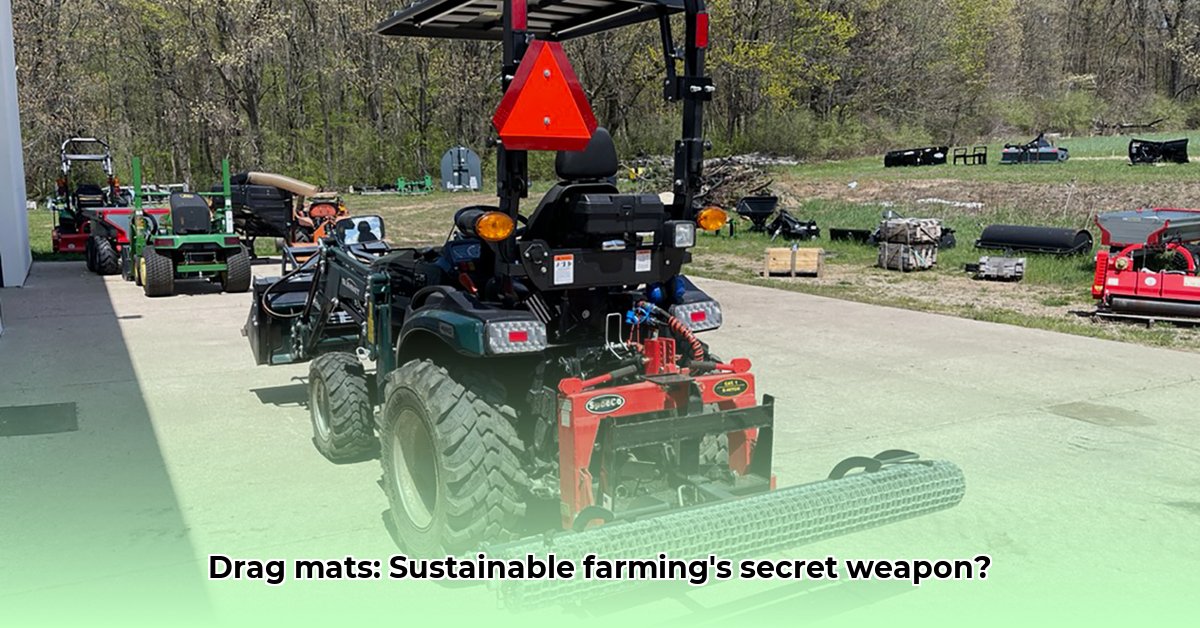
Exploring the Potential of Drag Mats in Sustainable Agriculture
Drag mats, heavy-duty textiles towed behind tractors, are generating interest within the sustainable agriculture sector. Their potential applications in soil erosion control and water management are promising, but current evidence remains limited. This article examines the potential benefits of drag mats while emphasizing critical research gaps and outlining future research directions needed to assess their true value in promoting sustainable farming practices.
Potential Applications and Limitations
Drag mats could potentially offer several benefits in sustainable agriculture. For example, they might reduce soil erosion by protecting newly sown seeds from wind and rain. Similarly, they could potentially be used for temporary water diversion, channeling runoff away from vulnerable areas. However, definitive conclusions on their efficacy cannot be drawn due to a lack of comprehensive research. The effectiveness of drag mats likely varies significantly based on soil type, climate, and the specific mat material used.
Critical Research Gaps: Unanswered Questions
Before widespread adoption, several crucial research gaps need to be addressed to determine the true role of drag mats in sustainable agriculture. These include:
Efficacy Across Diverse Conditions: Rigorous research is needed to evaluate the performance of drag mats across a wide range of soil types (e.g., sandy, clay, loamy) and climatic conditions. Currently, we lack sufficient data to assess their applicability across diverse agricultural landscapes. A lack of standardized testing protocols further complicates the evaluation process.
Long-Term Impact on Soil Health: The long-term effects of drag mats on soil health remain unclear. We need longitudinal studies spanning multiple growing seasons to assess their impact on soil structure, organic matter content, microbial communities, and overall soil fertility. This will enable a better understanding of their potential contributions to or detriments of long-term soil sustainability.
Environmental Footprint (Life Cycle Assessment): A comprehensive life-cycle assessment is crucial to evaluate the environmental impact of drag mat production, use, and disposal. This should consider the energy consumption, resource use, and greenhouse gas emissions associated with their manufacturing, as well as the potential for pollution from material degradation or improper disposal. Sustainable alternatives must be considered to mitigate environmental risks.
Comparative Analysis: To properly evaluate the effectiveness of drag mats, it is necessary to conduct comparative studies against established erosion control and water management methods. This allows for a holistic evaluation of their economic and environmental benefits in comparison to conventional and alternative solutions. The absence of such comparative studies hinders a complete understanding of their overall benefit within the context of other readily available tools.
Guiding Future Research: A Path Forward
Addressing the aforementioned research gaps requires a multi-faceted approach involving targeted research efforts. Specifically:
Large-Scale Field Trials: Conducting comprehensive field trials across a range of soil types, climates, and cropping systems is essential. These trials should use standardized methodologies and compare drag mat performance to other erosion control techniques. Replication across diverse locations is critical for generalizability.
Longitudinal Soil Health Monitoring: Implementing long-term monitoring programs that track key soil health indicators (e.g., organic matter, water infiltration rate, microbial biomass) over several years is necessary to determine the long-term effects of drag mats on soil ecosystems. The duration of these monitoring projects must be long enough to observe lasting impacts.
Comprehensive Life Cycle Assessments (LCAs): A thorough LCA is required to evaluate the environmental impact of drag mats across their entire lifecycle, from raw material extraction to final disposal. This will provide valuable insights into their environmental sustainability, even informing the design and creation of future, more environmentally friendly mats.
Comparative Effectiveness Studies: Conducting comparative studies that directly compare drag mats to other, established methods for erosion control and water management will help assess their cost-effectiveness and overall environmental impact within existing paradigms. This will enable more accurate decision-making.
Actionable Insights for Sustainable Agriculture
While the potential benefits of drag mats in sustainable agriculture are intriguing, further research is crucial. Farmers are advised to proceed cautiously, considering small-scale trials and monitoring the impact on soil health. Collaboration between researchers, farmers, and policymakers is essential for fostering innovation and adoption of sustainable agricultural practices. Only through rigorous scientific investigation can we accurately assess the true value and limitations of drag mats in sustainable agriculture.